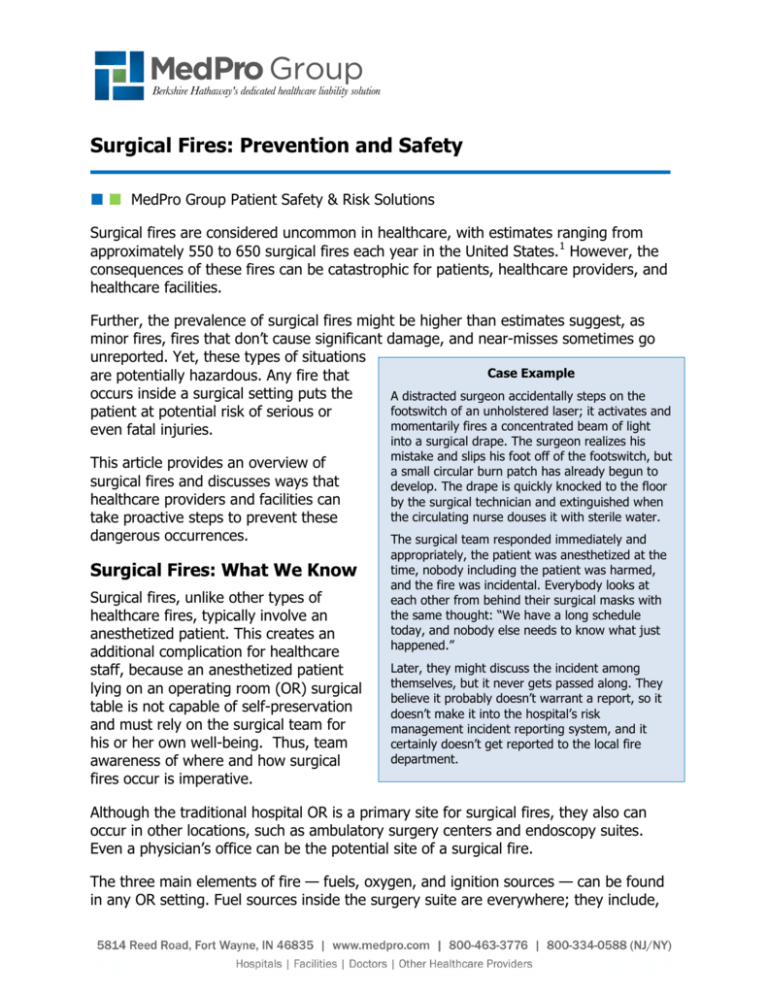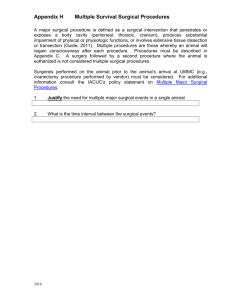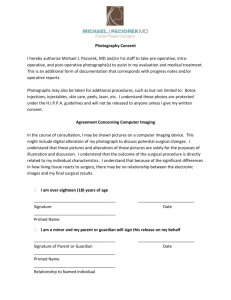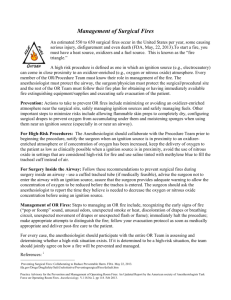
Surgical Fires: Prevention and Safety
MedPro Group Patient Safety & Risk Solutions
Surgical fires are considered uncommon in healthcare, with estimates ranging from
approximately 550 to 650 surgical fires each year in the United States. 1 However, the
consequences of these fires can be catastrophic for patients, healthcare providers, and
healthcare facilities.
Further, the prevalence of surgical fires might be higher than estimates suggest, as
minor fires, fires that don’t cause significant damage, and near-misses sometimes go
unreported. Yet, these types of situations
Case Example
are potentially hazardous. Any fire that
occurs inside a surgical setting puts the
A distracted surgeon accidentally steps on the
footswitch of an unholstered laser; it activates and
patient at potential risk of serious or
momentarily fires a concentrated beam of light
even fatal injuries.
This article provides an overview of
surgical fires and discusses ways that
healthcare providers and facilities can
take proactive steps to prevent these
dangerous occurrences.
Surgical Fires: What We Know
Surgical fires, unlike other types of
healthcare fires, typically involve an
anesthetized patient. This creates an
additional complication for healthcare
staff, because an anesthetized patient
lying on an operating room (OR) surgical
table is not capable of self-preservation
and must rely on the surgical team for
his or her own well-being. Thus, team
awareness of where and how surgical
fires occur is imperative.
into a surgical drape. The surgeon realizes his
mistake and slips his foot off of the footswitch, but
a small circular burn patch has already begun to
develop. The drape is quickly knocked to the floor
by the surgical technician and extinguished when
the circulating nurse douses it with sterile water.
The surgical team responded immediately and
appropriately, the patient was anesthetized at the
time, nobody including the patient was harmed,
and the fire was incidental. Everybody looks at
each other from behind their surgical masks with
the same thought: “We have a long schedule
today, and nobody else needs to know what just
happened.”
Later, they might discuss the incident among
themselves, but it never gets passed along. They
believe it probably doesn’t warrant a report, so it
doesn’t make it into the hospital’s risk
management incident reporting system, and it
certainly doesn’t get reported to the local fire
department.
Although the traditional hospital OR is a primary site for surgical fires, they also can
occur in other locations, such as ambulatory surgery centers and endoscopy suites.
Even a physician’s office can be the potential site of a surgical fire.
The three main elements of fire — fuels, oxygen, and ignition sources — can be found
in any OR setting. Fuel sources inside the surgery suite are everywhere; they include,
Surgical Fires: Prevention and Safety
2
but are not limited to, skin preparations, bone adhesives, aerosols, ointments, drapes,
scrubs, gowns, mattress pads, plastic bags, suction canisters, tubing, sponges, tapes,
dressings, gloves, suture supplies, wiring, and airway maintenance devices.
The surgical team must understand that any material or item with a carbon chemical
base can be ignited and will burn. Some skin-prepping agents and bone adhesives are
extremely flammable, and vapors can pool unnoticed underneath a patient.
Fuel sources also include patient-related items, such as body hair, fatty tissue, and
gastrointestinal gases, such as hydrogen and methane.
Oxygen sources inside the surgery suite include ambient air, medical air, nitrous oxide,
and an oxygen-enriched atmosphere. If an oxygen-fed fire occurs in the OR, staff
should anticipate a hot, rapidly intensifying, spreading fire. Any fire that involves an
oxygen-enriched atmosphere will be difficult to extinguish. Staff should also understand
that nitrous oxide, when subjected to a fire, can liberate oxygen to support combustion.
Typical ignition sources in the surgery suite include electrosurgical units, electrocautery
devices, fiberoptic light sources, lasers, defibrillators, drills, and electrical cords. Some
of these devices can produce temperatures in excess of several thousand degrees,
which greatly exceeds the normal ignition temperature of most fuel sources. Even after
these devices are used, the tip temperature can remain hot enough to ignite
surrounding fuel sources.
Some surgical fires last only seconds (i.e., flash fires). Others can grow exponentially —
e.g., a spark occurring in an oxygen-enriched atmosphere can grow to a fire in
nanoseconds that will challenge even the best-trained surgical staff. Once a fire begins
to develop and gain headway, it will be capable of producing hot toxic gases and
copious amounts of choking smoke. A growing fire of this magnitude will limit the staff’s
breathing and visibility. As hot toxic gases and smoke are produced, panic and
confusion may ensue.
Fortunately for healthcare providers and patients, most surgical fires can be prevented
through education, training, and strategies to minimize fire risks.
Preventing Surgical Fires
Educate and Train
Most surgical fire education and training is directed at a limited audience — the nursing
staff. Although the nursing staff usually controls the fuel sources, other team members
might control the other critical elements that can lead to fires.
For example, the surgeon typically controls the ignition sources, and the anesthesia
provider typically controls the oxygen sources. Also, it is possible that these activities
may overlap in a surgical setting.
Surgical Fires: Prevention and Safety
3
Thus, one of the best methods for preventing surgical fires is to educate and train every
member of the surgical team — e.g., the surgeon, surgical resident, anesthesia
provider, scrub nurse, circulating nurse, charge nurse, surgical technician, and
students — about the basic elements that contribute to fire and how best to control
them.
The following sections provide strategies for minimizing the risks associated with
ignition sources, fuel sources, and oxygen/oxidizer sources — the main elements of fire.
Organizations can use these strategies as part of fire prevention-focused education
efforts.
Implement Risk Strategies
Strategies From the Preventing Surgical Fires Initiative
In October 2011, the U.S. Food and Drug Administration (FDA) and its partners
launched the Preventing Surgical Fires Initiative to increase awareness of the risks of
surgical fires and promote the adoption of risk-reduction practices throughout the
healthcare community. * The initiative offers the following recommendations for
preventing surgical fires:
•
Conduct a fire risk assessment at the beginning of each procedure. The highest
risk procedures involve an ignition source, delivery of supplemental oxygen, and
the operation of the ignition source near the oxygen (e.g., head, neck, or upper
chest surgery).
•
Use supplemental oxygen safely.
o Evaluate if supplemental oxygen is needed for each patient. Any increase
in oxygen concentration in the surgical field increases the chance of fire.
o If supplemental oxygen is necessary, particularly for surgery in the head,
neck, or upper chest area:
Deliver the minimum concentration of oxygen needed to maintain
adequate oxygen saturation for your patient.
Use a closed oxygen delivery system such as an endotracheal tube
or laryngeal mask whenever possible, especially if high
concentrations of supplemental oxygen (greater than 30 percent)
are being delivered.
Take additional precautions to exclude oxygen from the field if
using an open delivery system. These precautions include draping
techniques that avoid accumulation of oxygen in the surgical field,
the use of incise or fenestrated drapes which may help isolate
*
In 2015, The Joint Commission (TJC) took leadership of the Preventing Surgical Fires Initiative, with the
Council for Surgical & Perioperative Safety hosting the initiative’s webpages and resources
(http://www.cspsteam.org/TJCSurgicalFireCollaborative/preventingsurgicalfires.html).
Surgical Fires: Prevention and Safety
4
oxygen from the surgical site, blowing air to wash out excess
oxygen, or alternatively, scavenging oxygen from the field.
•
Use alcohol-based (flammable) skin preparation agents safely.
o Prevent alcohol-based antiseptics from pooling during skin preparation.
For example use the appropriate size applicator for the surgical site.
o Remove alcohol-soaked materials from the prep area.
o Allow adequate drying time, as prescribed in the labeling, for the specific
product. If the product is used on hairy areas or in skin folds, extend the
drying time.
o Ensure the skin is dry before draping the patient and beginning surgery.
•
Use devices and other surgical equipment safely.
o Consider alternatives to using an ignition source for surgery of the head,
neck, and upper chest if high concentrations of supplemental oxygen
(greater than 30 percent) are being delivered. If an ignition source must
be used, know that it is safer to do so after allowing time for the oxygen
concentration to decrease. It may take several minutes for a reduction of
oxygen concentration in the area even after stopping the gas or lowering
its concentration.
o When not in use, place ignition sources, such as electrosurgical units and
electrocautery devices, in a holster — not on the patient or drapes.
o Understand that surgical drapes and other fuel sources can ignite easily
and burn in an oxygen-enriched environment, even if the products are
described as “flame-resistant.”
•
Encourage communication among members of your surgical team.
o Ensure the anesthesia provider delivering the gases is communicating with
the surgeon controlling the ignition source and the clinician applying the
skin preparation agent.
•
Plan how to manage a surgical fire. For example, understand how to extinguish a
fire burning on a patient, develop evacuation procedures, conduct fire drills, and
keep saline handy to put out a fire. 2
Other Strategies
In addition to the strategies described previously, the following tips also can help
surgical teams reduce the risk of OR fires.
•
Ensure that any piece of electrically powered equipment or equipment used to
supply power is operated in accordance with the manufacturer’s recommended
operating guidelines.
Surgical Fires: Prevention and Safety
5
•
Identify a current preventive maintenance sticker on medical equipment prior to
use. An additional biomedical engineering calibration sticker may also be placed
on the device, which will indicate the most recent measured output levels.
•
Remove from service and appropriately tag any piece of medical equipment that
has outdated sticker information, appears to be damaged, doesn’t work properly,
or is otherwise questionable in the mind of the operator. Do not change or alter
any medical device to improve the performance of that device.
•
Inspect cables and electrical supply cords in the surgical area before use. If the
cable or cord is too short, frayed, cut, or pulled tight, it could pose a potential
electrical safety concern.
•
Do not turn on medical devices prior to plugging them in to a receptacle.
Likewise, do not pull the plug out of a receptacle while a device is still on. Either
situation may increase the risk of a fire. If the device is placed on a cart, the cart
should be a stable platform not prone to tipping over.
•
If a piece of medical equipment begins to emit a burning odor or shows signs of
sparking or smoke, immediately unplug the device, remove it from the OR, and
call biomedical engineering immediately.
•
Operate electrosurgical units and electrocautery devices and lasers at the lowest
possible output settings to accomplish the surgery.
•
Any time a fiberoptic light source is used, secure it away from the ends of any
drape. Turn-off fiberoptic light sources when not in use.
•
Develop guidelines for patients that address hair care products, facial care
products, and makeup. Many times these products can add to the fuel load. Coat
any facial hair near the surgical site with a water soluble surgical jelly to
eliminate a potential fuel source.
•
Moisten sponges, gauze, and other items that are going to be used in or near the
surgical site with saline or sterile water to lessen the chance of ignition. Consider
using towels soaked in the same manner.
•
Replace oxygen tubing that is leaking as quickly as possible, and shut off oxygen
between surgical cases and overnight.
•
Handle nitrous oxide with the same precautions as oxygen, as it poses the same
hazard.
Conclusion
Although surgical fires are not common, they can have devastating effects on patients,
providers, and facilities. To mitigate the risks associated with surgical fires, education,
training, and awareness are essential. The surgical team should understand how fires
can potentially start in the OR and how to control heat, fuel, and oxygen sources.
Taking proactive steps to avoid and control fire risks may help prevent a tragedy.
Surgical Fires: Prevention and Safety
6
Endnotes
1
ECRI Institute. (2009, October). Press release: Preventing surgical fires: Important new
recommendations released. Retrieved from https://www.ecri.org/Press/Pages/
Preventing_Surgical_Fires.aspx
2
The Joint Commission. (2015). Recommendations for healthcare professionals on preventing surgical
fires. Retrieved from http://www.cspsteam.org/TJCSurgicalFireCollaborative/preventingsurgicalfires5.html
The information provided in this document should not be construed as medical or legal advice. Because
the facts applicable to your situation may vary, or the regulations applicable in your jurisdiction may be
different, please contact your attorney or other professional advisors if you have any questions related to
your legal or medical obligations or rights, state or federal statutes, contract interpretation, or legal
questions.
The Medical Protective Company and Princeton Insurance Company patient safety and risk consultants
provide risk management services on behalf of MedPro Group members, including The Medical Protective
Company, Princeton Insurance Company, and MedPro RRG Risk Retention Group.
© MedPro Group.® All Rights Reserved.






